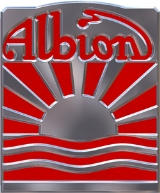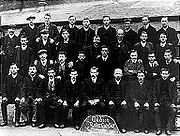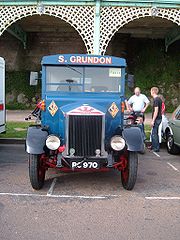
Albion Motors
Encyclopedia




Scotstoun
Scotstoun is a historic district of Glasgow, Scotland, west of Glasgow City Centre. It is bounded by Yoker and Knightswood to the west, Victoria Park, Broomhill and Whiteinch to the east, Jordanhill to the north and the River Clyde to the south...
, Glasgow
Glasgow
Glasgow is the largest city in Scotland and third most populous in the United Kingdom. The city is situated on the River Clyde in the country's west central lowlands...
is a former Scottish
Scotland
Scotland is a country that is part of the United Kingdom. Occupying the northern third of the island of Great Britain, it shares a border with England to the south and is bounded by the North Sea to the east, the Atlantic Ocean to the north and west, and the North Channel and Irish Sea to the...
automobile
Automobile
An automobile, autocar, motor car or car is a wheeled motor vehicle used for transporting passengers, which also carries its own engine or motor...
and commercial vehicle manufacturer, currently involved in the manufacture and supply of Automotive
Automotive industry
The automotive industry designs, develops, manufactures, markets, and sells motor vehicles, and is one of the world's most important economic sectors by revenue....
component systems.
Today the company is a subsidiary of American Axle & Manufacturing
American Axle
American Axle & Manufacturing, Inc. , headquartered in Detroit, Michigan, is a manufacturer of automobile driveline and drivetrain components and systems.-History:...
, and manufactures axles, driveline systems, chassis systems, crankshafts and chassis components. It is Scotland's best known name in the motor industry. Albions were renowned for their slogan "Sure as the Sunrise".
History
Originally known as Albion Motor Car Company Ltd, the company was founded in 1899 by Thomas Blackwood Murray and Norman Osborne Fulton (both of whom had previously been involved in Arrol-JohnstonArrol-Johnston
Arrol-Johnston was an early Scottish manufacturer of automobiles, which operated from 1896 to 1931 and produced the first automobile manufactured in Britain...
) they were joined a couple of years later by John F Henderson who provided additional capital. The factory was originally on the first floor of a building in Finnieston Street, Glasgow and had only seven employees. In 1903 the company moved to new premises in Scotstoun.
The Albion Motor Car Company Ltd was renamed Albion Motors in 1930.
In 1951, Leyland Motors took over. After the British Leyland Motor Corporation
British Leyland Motor Corporation
British Leyland was a vehicle manufacturing company formed in the United Kingdom in 1968 as British Leyland Motor Corporation Ltd . It was partly nationalised in 1975 with the government creating a new holding company called British Leyland Ltd which became BL Ltd in 1978...
was founded in 1968, production continued with the Albion Chieftain, Clydesdale & Reiver trucks and the Albion Viking bus models. Production of these was then moved to the Leyland plant at Bathgate
Bathgate
Bathgate is a town in West Lothian, Scotland, on the M8 motorway west of Livingston. Nearby towns are Blackburn, Armadale, Whitburn, Livingston, and Linlithgow. Edinburgh Airport is away...
in 1980. In 1969, the company took over the neighbouring Coventry Ordnance Works
Coventry Ordnance Works
Coventry Ordnance Works was a British manufacturer of heavy guns, particularly naval artillery. The firm was based in the English city of Coventry.-History:...
on South Street, which it continues to operate from.
Leyland dropped the Albion name when the company name was changed to Leyland (Glasgow) and later to Leyland-DAF from 1987 when it became a subsidiary of that Dutch concern.
A management buy-out in 1993 brought Albion Automotive as it was thenceforth known back into Scottish ownership. A new owner, the American Axle & Manufacturing Company (AAM) of Detroit, Michigan
Michigan
Michigan is a U.S. state located in the Great Lakes Region of the United States of America. The name Michigan is the French form of the Ojibwa word mishigamaa, meaning "large water" or "large lake"....
, took over Albion in 1998.
Passenger car manufacturing
In 1900 they built their first motor car, a rustic-looking dogcartDogcart
A dogcart is a light horse-drawn vehicle. There are several types:* A one-horse carriage, usually two-wheeled and high, with two transverse seats set back to back. It was known as a "bounder" in British slang...
made of varnished wood and powered by a flat-twin
Flat-twin
A flat-twin is a two cylinder internal combustion engine with the cylinders arranged on opposite sides of the crankshaft. It is part of the class of flat engines, sub-type "boxer", and shares most characteristics of those engines.-Motorcycle use:...
8hp
Horsepower
Horsepower is the name of several units of measurement of power. The most common definitions equal between 735.5 and 750 watts.Horsepower was originally defined to compare the output of steam engines with the power of draft horses in continuous operation. The unit was widely adopted to measure the...
engine with gear-change by "Patent Combination Clutches" and solid tyres.
In 1903 Albion introduced a 3115 cc 16 hp vertical-twin, followed in 1906 by a 24 hp four. One of the specialities the company offered was solid-tired shooting-brake
Shooting-brake
Shooting-brake, shooting brake or shooting break is a term for a car body style that has evolved through several distinct meanings over its history....
s. The last private Albions were powered by a 15 hp monobloc
Monobloc engine
A monobloc or en bloc engine is an internal-combustion piston engine where some of the major components: cylinder head, cylinder block, or crankcase are formed, usually by casting, as a single integral unit, rather than being assembled later...
four of 2492 cc.
Passenger car production ceased in 1915 but in 1920 the company announced that estate cars were available again based on a small bus chassis, it is not known if any were actually made.
Car models
- Albion 8 (1900–1904) 2080 cc twin-cylinder
- Albion 12 (1900–1906) 2659 cc twin-cylinder
- Albion 16 (1905–1913) 3141 cc twin-cylinder
- Albion 24/30 (1906–1912) 3164 cc 4-cylinder
- Albion 15 (1912–1915) 2492 cc 4-cylinder
Commercial vehicle production
Although the manufacture of motor cars was the main industry in the first ten years of its existence, it was decided in 1909 to concentrate on the production of commercial vehicles. During World War 1 they built for the war Office large quantities of 3 ton trucks powered by a 32 hp engine using chain drive to the rear wheels. After the war many of these were converted for use as charabancCharabanc
A charabanc or "char-à-banc" is a type of horse-drawn vehicle or early motor coach, usually open-topped, common in Britain during the early part of the 20th century. It was especially popular for sight-seeing or "works outings" to the country or the seaside, organised by businesses once a year...
s.
Trucks and buses (single and double deckers) were manufactured in the Scotstoun works until 1980 (1972 for complete vehicles). The buses were exported to Asia, East Africa, Australia, India and South Africa. Almost all Albion buses were given names beginning with "V", these models being the Victor, Valiant, Viking, Valkyrie, and Venturer.
Bus production
The earliest buses were built on truck chassis with two being delivered to West BromwichWest Bromwich
West Bromwich is a town within the Metropolitan Borough of Sandwell, in the West Midlands, England. It is north west of Birmingham lying on the A41 London-to-Birkenhead road. West Bromwich is part of the Black Country...
in 1914. Newcastle upon Tyne
Newcastle upon Tyne
Newcastle upon Tyne is a city and metropolitan borough of Tyne and Wear, in North East England. Historically a part of Northumberland, it is situated on the north bank of the River Tyne...
also took double deckers around this time, but Albion did not produce a purpose-built double deck chassis until 1931.
In 1923 the first dedicated bus chassis was announced derived from the one used on the 25 cwt truck but with better springing. Bodies seating from 12 to 23 passengers were available. A lower frame chassis, the Model 26, with 30/60 hp engine and wheelbases from 135 inches (3,429 mm) to 192 inches (4,876.8 mm) joined the range in 1925. All the early vehicles had been normal control, with the engine in front of the driver but in 1927 the first forward control with the engine alongside the driver was announced as the Viking allowing 32 seats to be fitted. Diesel engines, initially from Gardner, were available from 1933. The first double deck design was the Venturer of 1932 with up to 51 seats. The CX version of the chassis was launched in 1937 and on these the engine and gearbox were mounted together rather than joined by a separate drive shaft. Albion's own range of diesel engines was also made available.
After World War 2 the range was progressively modernised and underfloor engined models were introduced with two prototypes in 1951 and production models from 1955 with the Nimbus.
With the Leyland take over the range was cut back. The last Albion double decker was the 1961 Lowlander and that was marketed in England as a Leyland, and the last design of all was the Viking, re-using an old name.
Bus models
- Model 24 (1923–1924) First purpose built Albion bus chassis
- Viking 24 (1924–1932) Various wheelbases from 10 in 9 in (3.28 m) to 16 in 3 in (4.95 m) Front wheel brakes from 1927. Six cylinder engines available in Viking Sixes.
- Valkyrie (1930–1938) Forward control. 5 litre engine, 6.1 litre from 1933, 7.8 litre optional from 1935. Mainly sold as coaches.
- Valiant (1931–1936) Mainly sold to the coach market.
- Victor (1930–1939) Normal or forward control. 20 or 24 seater.
- Venturer (1932–1939) Albions first double decker. 51, later 55 seats. 3 axle version, the Valorous made in 1932, only one produced.
- Valkyrie CX (1937–1950) Engine and gearbox in-unit.
- Venturer CX (1937–1951) Double decker.
- Victor FT (1947–1959) Lightweight single decker
- Valiant CX (1948–1951) Mostly sold to coach operators.
- Viking CX (1948–1952) Mainly sold to the export market.
- NimbusAlbion NimbusThe Albion Nimbus was an underfloor-engined, ultra-lightweight midibus or coach chassis, with a four-cylinder horizontal diesel engine and a gross vehicle weight of six tons. It was happiest on light rural bus duties and private hires. Operators who used it on heavy-duty bus routes found it...
(1955–1963) Underfloor engine. - AberdonianAlbion AberdonianThe Albion Aberdonian was an underfloor-engined bus designed and built by Albion Motors between 1957 and 1960, it was introduced as a longer derivative of the Albion Nimbus....
(1957–1960) Underfloor engine. - Victor VT (1959–1966) Front engined
- Clydesdale (1959–1978) Export model built on truck chassis.
- Lowlander (1961–1966) Double decker. 18 in 6 in (5.64 m) wheelbase. LR5 and LR7 had air suspension.
- Viking VK (1963-1983?) Mainly exported. Leyland O.370 engine. VK43 model was rear engined.
Automotive components production
A complete change of profile went on in 1980. Since then, only automotive components, such as rear axleAxle
An axle is a central shaft for a rotating wheel or gear. On wheeled vehicles, the axle may be fixed to the wheels, rotating with them, or fixed to its surroundings, with the wheels rotating around the axle. In the former case, bearings or bushings are provided at the mounting points where the axle...
s, have been produced.
Firearms production
During World War II, Albion Motors manufactured Enfield No 2 Mk I* revolversEnfield revolver
Enfield Revolver is the name applied to two totally separate models of self-extracting British handgun designed and manufactured at the government-owned Royal Small Arms Factory in Enfield; initially the .476 calibre Revolver Enfield Mk I/Mk II revolvers , and later the .38/200 calibre Enfield No...
to aid the war effort. By 1945, 24,000 Enfield No 2 Mk I* revolvers were produced by Albion (and subsequently, Coventry Gauge & Tool Co.)
In popular culture
- Mark KnopflerMark KnopflerMark Freuder Knopfler, OBE is a Scottish-born British guitarist, singer, songwriter, record producer and film score composer. He is best known as the lead guitarist, vocalist, and songwriter for the British rock band Dire Straits, which he co-founded in 1977...
's song, "Border Reiver", the first cut on his 2009 release, "Get LuckyGet Lucky (Mark Knopfler album)Get Lucky is the sixth solo album by Mark Knopfler, released on 14 September 2009 in Europe and 15 September in the United States in three configurations...
", contains direct references "My Scotstoun lassie", "She's an Albion" and "Sure as the Sunrise"

